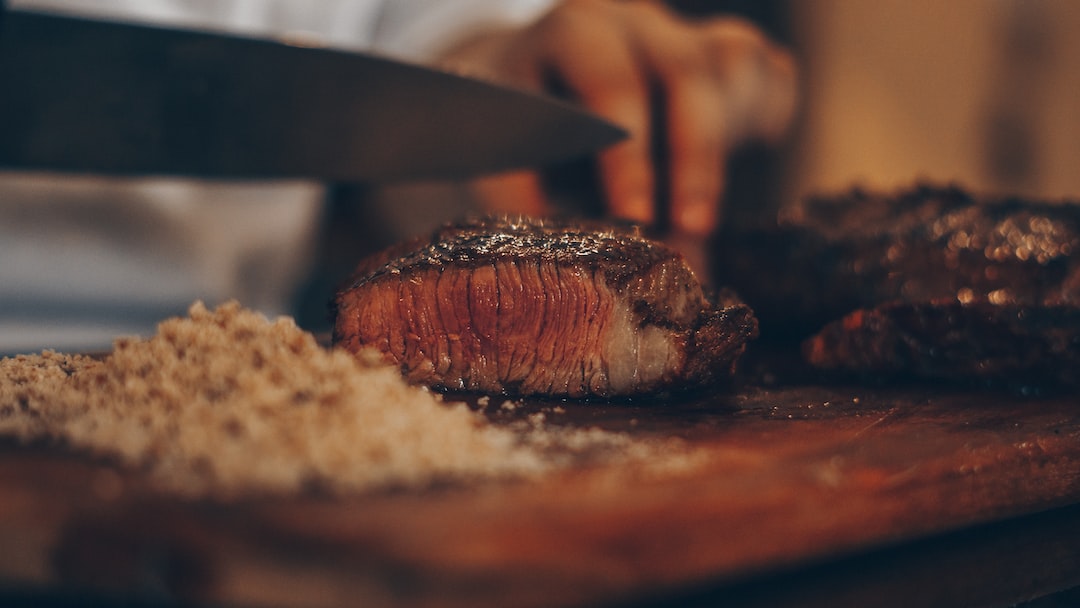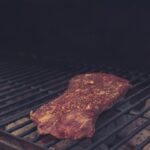If you’re a hunter or outdoor enthusiast, then chances are that you’ve heard of cooking deer steak.
But do you know the best way to prepare it? Do you have any favorite marinades for your deer steaks that will make them even more delicious? And what temperature should they be cooked at in order to ensure safe and delicious eating?
This blog post will provide all the answers and more. We’ll cover how to prep, cook, season, serve and store deer steak so that each bite is as flavorful as possible. So if you want to learn everything there is about cooking deer steak – read on.
Preparing the Deer Steak
When preparing a deer steak, selecting the right cut of meat is key. The best cuts are usually from the shoulder or hindquarters. You should look for a steak that has some fat marbling and an even thickness throughout.
Trimming and tenderizing the steak is important to ensure it cooks evenly and doesn’t have any gristle or sinew that can make it tough. Start by trimming off any excess fat, then use a sharp knife to score shallow cuts across both sides of the steak to break up muscle fibers before pounding with a mallet until it’s about 1/4 inch thick all around.
Marinating your steaks can add flavor as well as help them stay moist while cooking. Allow the steaks to soak in your chosen marinade for at least an hour so they can become infused with its flavors.
Once the steak is prepped, it’s time to infuse it with flavor through marinating. Cooking the deer steak requires careful consideration of technique in order to achieve optimal results.
Cooking the Deer Steak
Grilling deer steak is a great way to bring out its flavour – preheat the grill for 15 minutes on high heat, then season with salt and pepper or your preferred seasoning before laying the steaks over hot coals or gas flame. Before adding your steaks, preheat the grill for 15 minutes on high heat.
Season with salt and pepper or any other seasoning of choice, then place the steaks directly over the hot coals or gas flame. Grill each side for 3-4 minutes, flipping once halfway through cooking time. For medium rare doneness, remove from heat when internal temperature reaches 130°F (54°C). Let rest 5-10 minutes before serving.
Once the pan had reached a searing temperature, liberally season the steak with salt and pepper or any other desired spices. Place the steaks in the skillet without overcrowding to ensure they can develop an appetizingly golden-brown crust on each side without steam building up and impeding that process.
Fry for two to three minutes per side until cooked through – verify this by using a thermometer to check that it has reached an internal temperature of 130°F (54°C) for medium rare doneness.
Subsequently, remove from heat onto a plate lined with paper towels to absorb any excess fat or oil then let rest for five to ten minutes before serving warm. Keywords: active voice, idioms, colloquialisms, keywords, grammar, spelling, punctuation
Preheat the oven or Traeger to 177˚C and season steaks with salt, pepper, and other herbs/spices. Place the steaks on a roasting rack set inside of a baking sheet – this will prevent burning due to direct contact with metal tray by allowing air flow that circulates around the entire cutlet for more consistent results overall.
Roast for 10-15 minutes depending on size and thickness, then use an instant read thermometer inserted into thickest part to check temperature reads 130˚F (54°C). Let rest for few minutes prior slicing, serve warm and savor.
Set your smoker up according to the wood type and fuel you’re using, following the manufacturer’s instructions for proper setup and safe operation of the unit. Charcoal or electric smokers may require different preparation steps than pellet fueled units, so be sure to consult your manual first before getting started.
Once it’s ready to go, place seasoned deer cuts on either racks provided in the smoker or trays if necessary. Smoke at low-slow temperatures between 225–250 degrees Fahrenheit (110–120 Celsius) for 4–6 hours depending on size and thicknesses being smoked – use a thermometer inserted into thickest part to check that temperature reads 140˚F (60°C).
When done, remove from heat and let cool for few minutes prior slicing; serve warm and savor. Keywords: active voice, idioms, colloquialisms, keywords grammar spelling punctuation
Searing the Steak on a Cast Iron Skillet:
Searing is another excellent method to prepare delicious venison dishes in your home kitchen, and cast iron skillets are the ideal tool for the job thanks to their superior ability to retain heat and create beautiful sear marks on both sides of the cutlet.
Start off by preheating your skillet at high or medium temperatures for 8-10 minutes respectively, ensuring it becomes very hot prior to adding oils or fats to help prevent sticking. Coat the skillet lightly with oil of your choice, then season it generously with sea salt and freshly ground pepper.
Finally lay down prepared pieces one time, avoiding overcrowding so there’s plenty of room for air circulation and movement freely; otherwise you won’t be able achieve desirable results when searing. Cook 1-2 minute per side checking frequently using tongs to flip over and ensure it’s not burning but only caramelizing nicely.
After finished turn off burner transfer plate covered with foil tent and let sit five to ten minutes relax juices redistribute throughout interior portions resulting in a tender succulent bite every time.
Cooking a deer steak is an art form that can be mastered with the right techniques and seasonings. With these steps in mind, you will be well on your way to creating delicious meals from this versatile game meat. Now let’s explore some of the best ways to flavor and enhance your deer steaks for even more mouthwatering results.
Seasoning and Flavoring Your Deer Steak
When it comes to seasoning and flavoring your deer steak, there are many popular spices that will add depth of flavor. Popular spices for deer steaks include garlic powder, onion powder, smoked paprika, oregano, thyme, rosemary and cumin.
For an optimal flavor, it is recommended to combine these spices or use them separately. When using these spices together make sure to mix them well before adding them to the steak so they blend evenly throughout the meat.
Marinades are also a great way to season and tenderize your deer steak prior to cooking. Marinades typically contain an acidic component such as vinegar or citrus juice along with oil and herbs or spices like garlic powder, onion powder, smoked paprika oregano etc., which helps break down some of the tougher muscle fibers in the meat making it more tender when cooked.
The marinating period can span anywhere from an hour to four, depending on the pre-cooking timeframe.
Finally, sauces can be used as a condiment or accompaniment for your finished deer steak dish. Popular sauces include BBQ sauce (which pairs nicely with grilled venison), chimichurri (a South American herb based sauce) or a classic red wine reduction sauce which is perfect for pan-fried steaks served over mashed potatoes or polenta.
Sauces help bring out all of those flavors that were created during marinating and seasoning process creating a delicious meal.
For flavoring your deer steak, there are myriad options to explore. Experimenting with a range of marinades, spices, and sauces can give your deer steak an exceptional flavor that will wow. Next up is serving and eating your delicious creation – let’s learn how.
Serving and Eating Your Deer Steak
When serving and eating deer steak, it is important to understand the right temperature for cooking. A properly cooked deer steak should be cooked to an internal temperature of 145°F or 63°C.
To ensure optimal juiciness and tenderness, it is recommended to let the steak rest for 5 minutes after cooking. It’s also a good idea to let your steak rest after cooking for at least 5 minutes before slicing and serving. This allows the juices in the meat time to redistribute, making it even more delicious.
For the most tender bites, cut your steaks against the grain at a 90-degree angle in thin strips of about ¼ inch. To do this, look for lines running through your steak and cut perpendicular (at a 90-degree angle) across them. Slice into thin strips about ¼ inch thick for optimal flavor and texture when eating.
Serve your deer steaks with some freshly roasted vegetables or mashed potatoes on the side, along with some homemade gravy or sauce if desired – just like Grandma used to make. You can also add some freshly chopped herbs such as rosemary or thyme over top of everything before serving; this adds an extra layer of flavor which really brings out all those wonderful flavors in each bite.
It is essential to ensure that the deer steak has been cooked throughly when consuming it, in order to guarantee its safety. Now let’s look at how you can store any leftover deer meat safely for future meals.
Storing Leftover Deer Meat Safely
When dealing with preserving any remaining deer meat, certain protocols should be observed to guarantee safety. Immediately after harvesting the animal, it is essential to refrigerate the meat at a temperature below 40°F to prevent bacteria growth.
The key here is to keep the temperature of the refrigerator below 40°F in order to prevent bacteria from growing on any remaining meat. It’s also important to wrap or store your deer steaks in an airtight container or zip-top bag before refrigerating them so they don’t absorb other flavors from other food items stored in your fridge.
Freezing leftovers is another great way of preserving deer meat for later use, but it does require some extra preparation beforehand. Before putting the venison steaks in a freezer bag, make sure they are wrapped up air-tightly with either plastic wrap or freezer paper to keep out any moisture.
Once everything is properly packaged, place them inside a large freezer bag and squeeze out as much air as possible before sealing it shut. This will help keep moisture away from your frozen cuts of venison which can cause spoilage over time if not prevented correctly.
Finally, when reheating leftover deer steak it is essential that you do so safely by bringing it up slowly over low heat rather than blasting it at high temperatures right away. This helps retain more flavor while ensuring that harmful bacteria does not have a chance to grow due to uneven heating throughout the cut of meat itself.
Additionally, try adding spices like garlic powder or onion powder while reheating for an extra kick of flavor; just remember not to add too much salt since most game meats already contain natural salts within their own juices. Confidently know that your game meat leftovers will be safe and scrumptious when reheated with these guidelines.
FAQs in Relation to How to Cook Deer Steak
How should deer steak be cooked?
Deer steak should be cooked quickly over high heat to seal in the juices and flavor. Sear the steak for a brief period on both sides, then reduce the heat and cook each side for several minutes depending on its thickness.
Avoid cooking too long as this will make the steak dry. Let rest 5-10 minutes before serving for optimal tenderness and flavor.
What is some good ways to cook deer meat?
Cooking deer meat can vary, based on the cut and individual taste. Grilling is an excellent option for tender cuts like backstrap or medallions. For tougher cuts, such as shoulder roast or shanks, braising with vegetables and herbs yields delicious results.
Roasting over indirect heat also works well for larger pieces of venison. Slow cooking in a crockpot produces flavorful pulled deer sandwiches when combined with barbecue sauce. Finally, ground deer can be used to make burgers that are just as tasty as their beef counterparts.
Do you have to soak deer steak before cooking?
No, you do not need to soak deer steak before cooking. In fact, soaking can cause the meat to become waterlogged and lose flavor. Marinating a deer steak in an acidic mixture for several hours prior to cooking will help tenderize the meat and add flavor.
This will help tenderize the meat and add flavor. When ready, season with salt and pepper or your favorite herbs and spices then cook over medium-high heat until desired doneness is reached.
How do you make deer steak taste good?
Deer steak can be made delicious with the right marinade. Season the steak with salt and pepper, as well as herbs and spices such as garlic powder, onion powder, paprika, oregano or thyme to give it flavor before marinating.
Once you’ve added the seasonings to both sides of the steak, cover it in an acidic liquid like red wine vinegar or balsamic vinegar for at least 4 hours before cooking. This will tenderize and infuse flavor into your meat. Finally grill or pan fry on high heat until cooked through; enjoy.
Conclusion
Cooking deer steak is a great way to enjoy the bounty of nature. Whether you choose to cook it on your Traeger, grill, or in a pan – be sure to marinade and season with popular spices for an unforgettable flavor experience.
Make sure that your deer steak reaches at least 165°F before serving so that all harmful bacteria are destroyed. Enjoy this delicious meal and store any leftovers safely in the refrigerator.



